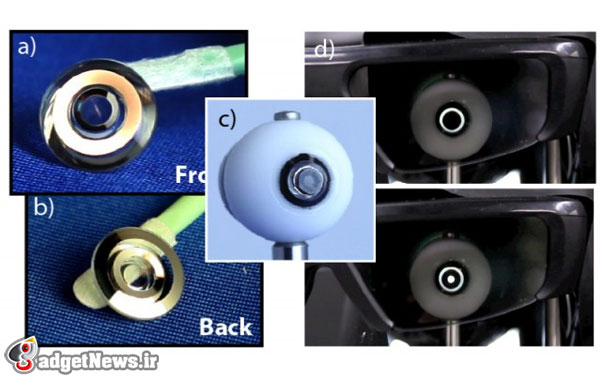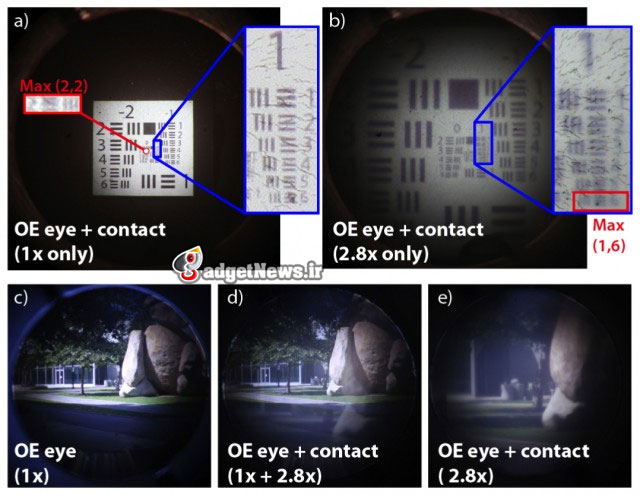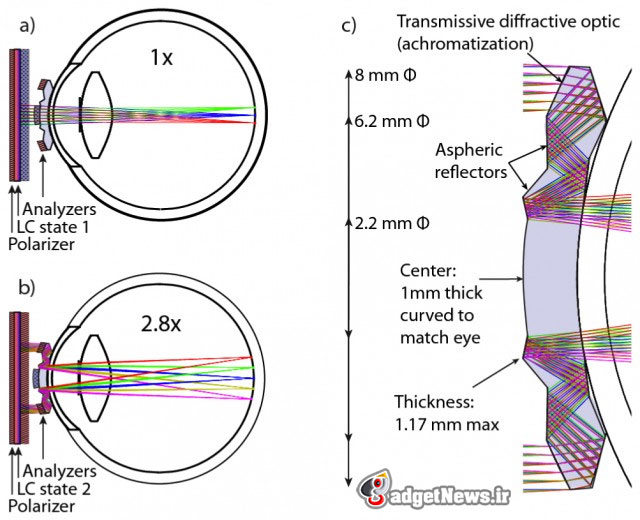
يکي از آرزو هاي بشر دستيابي به قابليت هاي ابر انساني بوده و هست و اکنون به لطف فناوري هاي جديد ديگر کار از داستان هاي کتاب هاي مصور و شخصيت هاي فيلم هاي هاليوودي گذشه و اين آرزو در حال تحقق يافتن است. گروهی از محققان بین المللی اولین کانتکت لنز تلسکوپی را ساختند. کانتکت لنزی که اگر آن را روی چشم بگذارید، خواهید توانست هر چیزی که میبینیند را تا سه برابر بزرگنمایی کنید.
این لنز از دو بخش تشکیل شده: بخش میانی که نور از آن رد شده و دید معمولی را ممکن می کند و بخش کناری که به شکل تلسکوپی ساخته شده و امکان زوم ۲.۸ برابر را به کاربر می دهد. تصاویر زیر نشان دهنده زومی هستند که با این لنز به دست می آید:

برگ برنده این کانتکت لنزها، عرض ۱.۱۷ میلیمتری آنها است که اجازه می دهد بدون دردسر روی چشم قرار بگیرند. نمونههای قبلی ۴.۴ میلیمتر ارتفاع داشتند که استفاده از آنها را در زندگی واقعی، غیرعملی می کرد.

منبع : extremetech
World’s first telescopic contact lens gives you Superman-like vision
An international team of researchers have created the first telescopic contact lens; a contact lens that, when it’s equipped, gives you the power to zoom your vision almost three times. Yes, this is the first ever example of a bionic eye that effectively gives you Superman-like eagle-eye vision.
As you can see in the photo above, the telescopic contact lens has two very distinct regions. The center of the lens allows light to pass straight through, providing normal vision. The outside edge, however, acts as a telescope capable of magnifying your sight by 2.8x. This is about the same as looking through a 100mm lens on a DSLR. For comparison, a pair of bird-watching binoculars might have a magnification of 15x. The examples shown in the image below give you a good idea of what a 2.8x optical zoom would look like in real life.
The telescopic contact lens, in action
The main breakthrough is that this telescopic contact lens is just 1.17mm thick, allowing it to be comfortably worn. Other attempts at granting telescopic vision have included: a 4.4mm-thick contact lens (too thick for real-world use), telescopic spectacles (cumbersome and ugly), and most recently a telescopic lens implanted into the eye itself. The latter is currently the best option currently available, but it requires surgery and the image quality isn’t excellent.
To create a 1.17mm-thick telescope, the researchers — led by Joseph Ford of UCSD and Eric Tremblay of EPFL — had to be rather creative. The light that will be magnified enters the edge of the contact lens, is bounced around four times inside the lens using patterned aluminium mirrors, and then beamed to the edge of the retina at the back of your eyeball. The mirrors magnify the image 2.8 times, but also correct for chromatic aberration, resulting in a surprisingly high fidelity image. To switch between normal and telescopic vision, the central (normal, unmagnified) region of the contact lens has a polarizing filter in front of it — and then the wearer equips a pair of 3D TV spectacles. By switching the polarizing state of the spectacles (a pair of active, liquid crystal Samsung 3D specs in this case), the user can choose between normal and magnified vision.
How the telescopic contact lens works
In case you were wondering, these solutions all primarily exist for one reason: To help restore sight to people with age-related macular degeneration. AMD damages the high-resolution fovea at the center of the retina, but generally the low-resolution outer region (perifovea) still works. Without the fovea, people with AMD can’t make out fine details, such as type on a page. These telescopic spectacles, lenses, and implants focus light onto this outer region, giving people with AMD the ability to make out these details.
The current telescopic contact lens is made out of PMMA, a gas-impermeable polymer that old, uncomfortable contact lenses used to be made of. To bring their lens to market, the researchers will need to switch over to rigid gas permeable (RGP) polymers, which modern, comfortable contact lenses are made from. While these telescopic lenses are obviously intended for people who suffer from AMD, there’s nothing to prevent a healthy person from wearing them and achieving better-than-human (superhuman?) vision.
 گجت نیوز آخرین اخبار تکنولوژی، علم و خودرو
گجت نیوز آخرین اخبار تکنولوژی، علم و خودرو 





